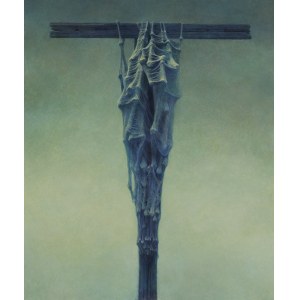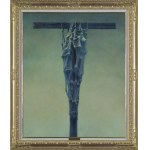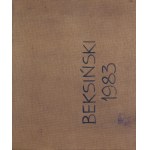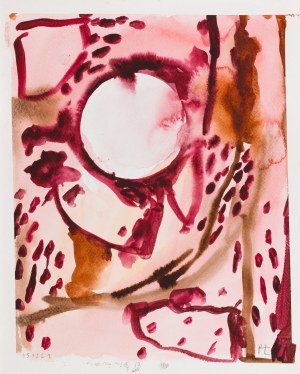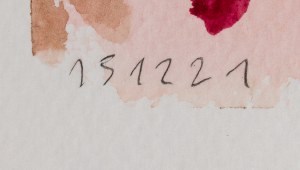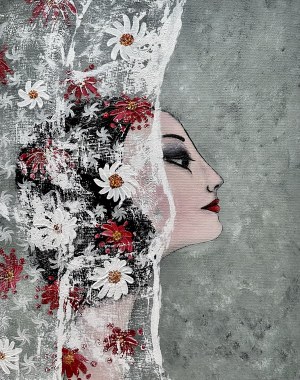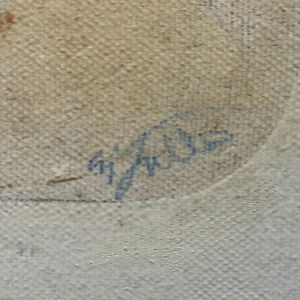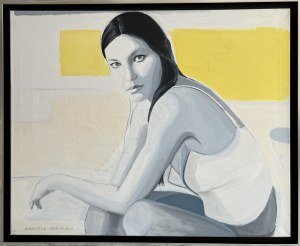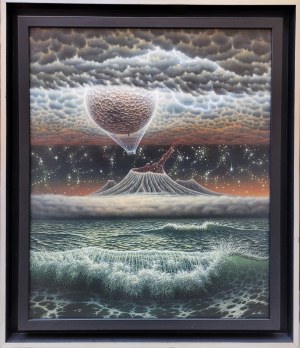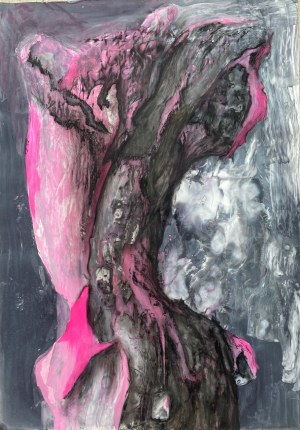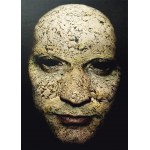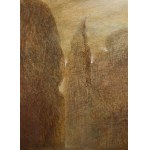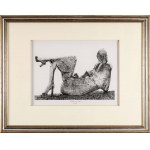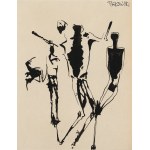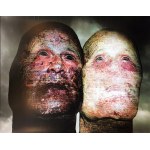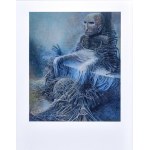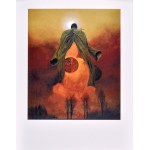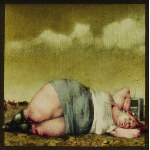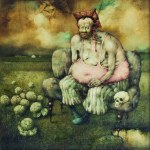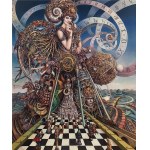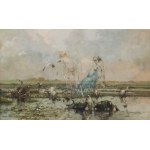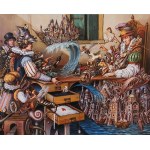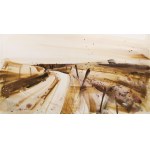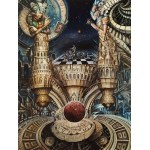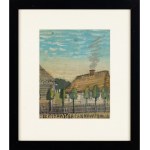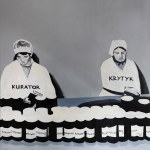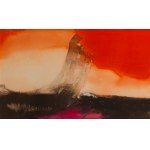Signed on reverse: BEKSIŃSKI | 1983
reverse l.d. stamp authorizing export with signature
Provenance:
- The painting was purchased in 1990 in Paris for the Museum of European Art in Osaka, Japan.
- After museum closure, private collection in Asia.
Image exhibited, reproduced and described:
- Beksinski. Paris-Osaka-Warsaw, Agra-Art Gallery, Warsaw 1 July - 4 September 2021, cat. no. 15, pp. nlb. ill. in color;
- Japanese Collection. Beksinski and others, Agra-Art, Warsaw 2021, p. 42, color ill.
- Dmochowski Gallery NET (Virtual Museum) website.
Representations of crucifixion - systematically undertaken by the artist over the years - were most common in the so-called fantastic period (1968-1983). Stretched on the beams of the cross: skeletons, animal-human carcasses, women-demons epitomizing predatory sexuality - perfectly matched the near-horror aesthetics of the paintings of the Master from Sanok. He himself has more than once admitted his fascination with the crucifix motif:
I have been painting crosses and crucifixions since childhood. They used to include various persiflages and even paintings with erotic overtones. Nowadays, and for years, I have already approached this motif directly. I can't explain why exactly this motif makes such a strong impression on me, but first of all it is the motif. As a painter, I am just responding with my crucifixion to the crucifixion of Rembrandt, Grunewald, or finally the hundreds and thousands of nameless artists found in hundreds and thousands of churches and cemeteries. It's like the Requiem, which is almost as a rule composed to the same text. However, I do not back down from the fact that it is a special motif for me, but precisely as a vision, not as a creed. It is dominated by art history, not faith.
(Melancholy is closest to me, interviewed by J. Anna Luzynska, "Sycyna", 1995, no. 17, pp. 3-4)
In the presented painting, far from the Latin iconic depiction, the role of the crucified figure is played by human remains shrouded in a thick web. The near-macabre variation of this key theme in the Christian religion is encapsulated in a highly aesthetic form. Sophisticated color nuances bring out the intricate pseudo-anatomical structure from the background, while keeping the whole in a blue, cool tonality introduces a mood of melancholy and suspenseful anticipation. The choice of means used and the craftsman's precision of execution make it impossible to consider this unique work in terms of provocation or profanity, but only - beauty. Possible religious symbols, Wieslaw Banach reminded, were for the artist only formal and compositional matter from which he constructed his visionary images.
Zdzislaw Beksinski:
(Sanok 24 II 1929 - Warsaw 21 II 2005) studied from 1947 to 1952 at the Faculty of Architecture of the Cracow University of Technology.
He was a self-taught artist who achieved an unquestioned position in Polish contemporary art, confirmed by the presence of his works in prestigious exhibitions and museum collections. He was initially involved in photography, which he had been interested in since his student years, after 1956 gaining recognition as a creator of photograms with an aesthetic based on textural effects. In 1958-1962, he created abstract paintings-reliefs of rich texture, mainly metal, which are a variation of matter painting. Toward the end of this period, he created openwork forms with figure shapes and full-bodied sculptures in metal. The next stage of his work was 1962-1974, when he devoted himself mainly to drawing. In the 1960s he drew with pen and ink figural compositions characterized by caricatured deformation of figures. From the late 1960s, he created charcoal and crayon drawings, a monochromatic variant of his parallel painting work. Since 1974, he has dealt almost indivisibly with painting. His distinctive style was based on technical perfection, accompanied by an extraordinary vision. He painted a post-disaster world, marked by the stigma of death and decay. His paintings are populated by figures and creatures with admittedly human or animal shapes, but with the characteristics of phantoms, automatons or decaying corpses. The artist did not give his paintings and drawings titles (except for ordering symbols), thus emphasizing his lack of interest in the literary side of the depictions. He himself said that when painting he completely surrenders to the vision, "photographing" it. In recent years, he has incorporated electronic image generation techniques into his artistic technique, which he used to create computer photomontages. Beksinski's art, which has been exhibited and discussed many times, arouses extreme emotions among experts and the public.
The largest, systematically supplemented collection of his works in the country is in the Historical Museum in Sanok, abroad - in Paris, in the possession of Piotr Dmochowski, who has been collecting works and promoting the artist's work since 1983. He organized individual exhibitions of Beksinski at, among others, Galerie Valmay in Paris in 1985, 1986 and 1988, as well as a permanent exhibition at Dmochowski's own Galerie - Musée-galerie de Beksinski, which existed in 1989-1996. He also published monumental albums of the artist in 1988 and 1991. In Poland, Beksinski's monograph by Tadeusz Nyczek was published by Arkady in 1989 (second edition in 1992). In the spring of 2005, a major exhibition of Beksinski's paintings took place at the Abbotsford Palace in Gdansk Oliva, and the director of the Sanok Museum Wieslaw Banach published a comprehensive monograph on the artist.
Since October 2016, an exhibition of 250 works (paintings, drawings, photographs) by Zdzislaw Beksinski from the private collection of Anna and Piotr Dmochowski has been permanently installed at the Nowa Huta Cultural Center. Meanwhile, a permanent exhibition of 30 Beksinski paintings from the Dmochowskis' collection has also been on display at the Archdiocese Museum in Warsaw since June 2021.



